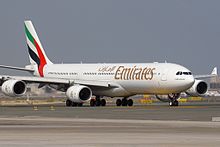Emirates Flight 407

A6-ERG, the aircraft involved, at Zürich Airport in 2007.
|
|
| Accident summary | |
|---|---|
| Date | 20 March 2009 |
| Summary | Tailstrike on takeoff and runway overrun |
| Site | Melbourne, Australia 37°40′14″S 144°50′17″E / 37.67056°S 144.83806°ECoordinates: 37°40′14″S 144°50′17″E / 37.67056°S 144.83806°E |
| Passengers | 257 |
| Crew | 18 |
| Fatalities | 0 |
| Injuries (non-fatal) | 0 |
| Survivors | 275 (all) |
| Aircraft type | Airbus A340-541 |
| Operator | Emirates |
| Registration | A6-ERG |
| Flight origin | Auckland International Airport |
| Stopover | Melbourne Airport |
| Destination | Dubai International Airport |
Emirates Flight 407 was an Emirates flight flying from Melbourne to Dubai using the Airbus A340-500. On 20 March 2009, the flight failed to take off properly at Melbourne Airport, hitting several structures at the end of the runway before eventually climbing enough to return to the airport for a safe landing. Although no fatalities or injuries resulted, damage to the aircraft was severe enough for the event to be classified by Australian Transport Safety Bureau as an "accident". It has been described "as close as we have ever come to a major aviation catastrophe in Australia" by aviation officials.
The scheduled flight departed from Melbourne as planned at 22:30 using the 3,657-metre-long (11,998 ft) Runway 16. 1,043 m (3,422 ft) before the end of the runway, travelling at a speed of 270 kilometres per hour (168 mph), the captain ordered the first officer to rotate. As the aircraft pitched upward it failed to leave the ground and the tail section struck and continued to scrape along the runway. The captain took over the controls and applied maximum thrust on all four engines by using the Take-off/Go-around (TOGA) detent. After exhausting the entire length of the runway, the aircraft failed to become airborne, and did not leave the ground until 148 m (486 ft) beyond the end of the runway. The captain later said "I thought we were going to die. It was that close".
Subsequently, the aircraft hit a strobe light at the end of the runway and continued to climb with difficulties. At 350 m (1,148 ft) beyond the end of the runway, the landing gear hit and damaged the 1.8 m (6 ft) high localiser antenna array operated by Airservices Australia. At 500 m (1,640 ft) beyond the end of the runway, the aircraft barely missed the 2.24 m (7 ft) tall airport perimeter fence. It was also reported that after clearing the airport perimeter, the aircraft cleared a small brick building by only 50 centimetres (20 in).
The aircraft eventually climbed away over Port Phillip Bay. The first officer then reviewed the take-off performance calculations in his electronic flight bag, and discovered that he had understated the aircraft's weight by 100 tonnes (262.9 tonnes instead of 362.9). This meant that an incorrect flex temp was applied, which had resulted in a lower than necessary engine thrust and consequently insufficient acceleration and airspeed.
...
Wikipedia
